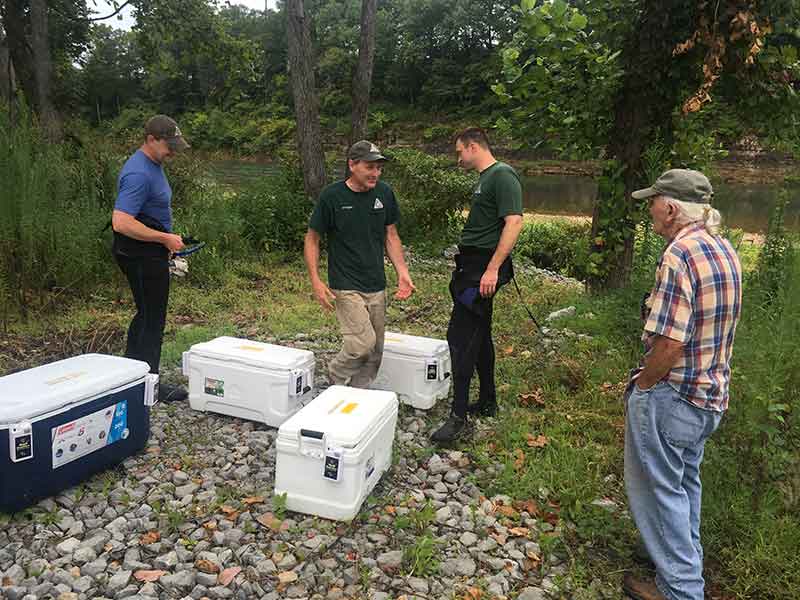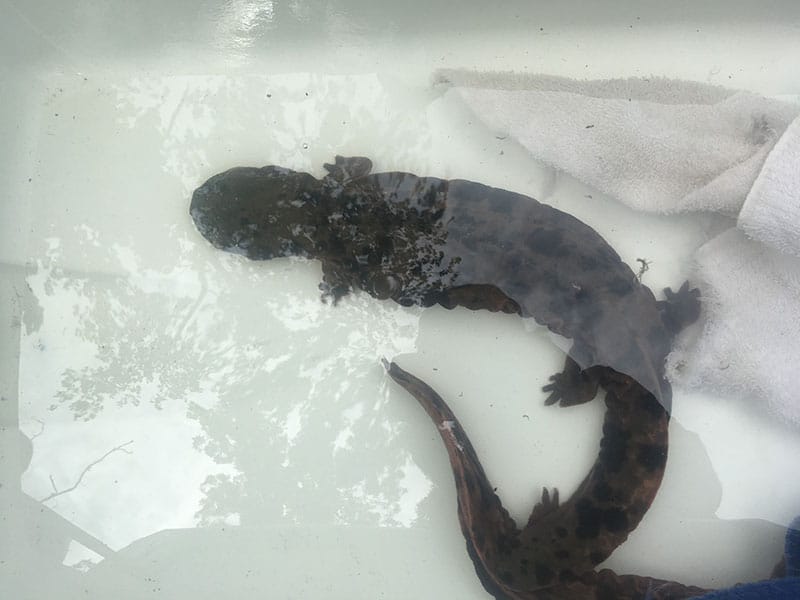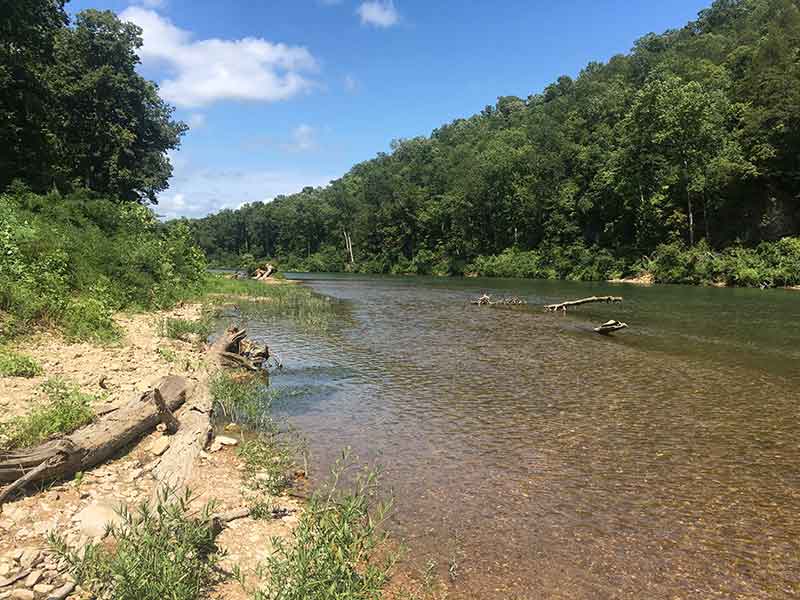Having seen him drive in, Dave Flamm, an older man with a ponytail, comes out of an RV to greet him. Behind the RV is a flat patch of grass where, two years before, Dave’s house stood, until the flood in 2017. Dave is happy to see the man intent on restoring the North Fork River.
The Hellbender Whisperer is Jeff Briggler, a confident, wiry Missouri Department of Conservation (MDC) herpetologist with a distinctly Arkansan accent.
In Jeff’s truck are six coolers filled with a hundred Ozark hellbenders, an endangered and giant species of salamander endemic to the Missouri and Arkansas Ozarks. One of the most unique organisms in the region, its olive-black body is flat, wrinkly, and wriggly, and it can grow nearly two feet long, making it the continent’s largest amphibian. Fleshy folds on its skin give it more surface area to breathe underwater. Its beady eyes make it look blind as it stalks the riverbed on foot, hunting for small fish and crawdads.
The etymology is unclear, but one MDC source speculates it was first called a “hellbender” because it looked like “it was a creature from hell where it’s bent on returning.” They’re so rare that, even though they can live for thirty years, most people in the Ozarks have never seen one. It’s often called a snot otter.
“God, they’re ugly,” Dave says.
“Hey, now!” Jeff cries, unloading hellbenders into buckets for release. Fifty-nine of his one hundred hellbenders will be released into the river.
“I have yet to touch a hellbender,” Dave says. “I‘m gonna reach in there and pick one of them suckers up even if it dies.”
“No, don’t—I can‘t hear that!”
Hellbenders are highly ecosystem sensitive, needing deep pools of clear, clean water with rocks they can nest beneath. The North Fork’s fast-moving, spring-fed current used to be ideal. In many areas of its small range, habitat destruction, disease, and disruption by collectors have left populations endangered. Until the 2017 flood, the North Fork of the White River was known as a stronghold for Ozark hellbenders.
“Man, there wasn’t any hellbenders left, was there?” Dave asks. “If there was, I don’t know how they survived.”
“I still find a nest occasionally,” Jeff says. “Not a lot.”
The river behind the two men has little to do with the river before 2017. For one, you can see it. The riparian corridor of sycamores went down with the flood. Upstream, one of Dave’s neighbors estimated he cleaned 250 downed trees off his 400-foot stretch of riverbank. From the other bank rises a 20-foot limestone cliff that would have been totally invisible behind vegetation before the flood.

The Ozarks had historic flooding in late April 2017. One night, the downpour started and simply didn’t let up. It poured for hours, then more hours.
Dave and his neighbors scrambled for higher ground, abandoning uninsured houses. Seven of them huddled in their highest neighbor’s home, waiting out the storm. “We were trapped,” Dave says. “It was just an island up here.” Some claimed to hear boulders crashing downstream through the darkness.
No one knows exactly how high the river got, but they know it broke the previous record by about seven feet. Miraculously, no one died.
The 2017 flood sent gravel washing into the North Fork, where it remains today. The graveling of Ozark streams is not new, having occurred through erosion since the cutting of Ozark forests in 1880. But due to a lack of riparian corridor on nearby farmland, the floodwaters, combined with the sediment dropped and the loss of vegetation, caused the channel in stretches like the one behind Dave’s place to widen out. As a result, the once narrow and fast-moving channel of the North Fork now spreads out and slows down, dropping sediment into and filling riverbed holes where hellbenders would normally have nested.
If something disturbs a hellbender nest, it won’t return to it. The flood crushed the hellbenders’ habitat. Every rock in the river was overturned or pummeled in the flow, wiping out hellbender habitat like an F5 tornado moving through a village.
“I spend so much time here, I probably could’ve told you where every rock, nest site, and animal were,” Jeff says. “I’m relearning this whole section now. Most of the nests I’ve found in here historically, I can’t find anymore. It either dug them out—and it looks different—or it just piled rocks on top of them. Some of these sites we go back to where we could catch ten or twenty hellbenders—we’re lucky if we catch two.”
That’s why Jeff is here. In a normal year, Jeff spends about a fourth of his time as state herpetologist working on hellbenders. He visits rivers all over the Ozarks, not only to release captive hellbenders, as he is today, but also to search out nests and eggs and to monitor hellbender trends. He is careful not to disturb the nests.

Different rivers give him different results. For example, the eastern hellbender, a separate subspecies that is not endangered and found throughout Appalachia, is found in Missouri only in north-flowing rivers like the Big Piney and the Gasconade, while Ozark hellbenders are only found in south-flowing rivers like the North Fork and the Current.
Even among Ozark hellbender rivers, there are differences. Rivers like the Current and the Eleven Point have banks protected by the National Park Service and the US Forest Service, respectively, meaning that when a major flood hits, they have strong riparian buffers to protect them. For the mostly privately owned North Fork, “It was like a bomb going off. It just stripped everything off,” Jeff says. So while the North Fork was once the champion of hellbender habitat, the crown now belongs to the better protected Current.
He estimates they lost about 50 percent of the North Fork’s hellbender population in that event alone. “I’ve never seen anything like this in my life,” he says. More than three years later, as he helps to restock the river with captive-bred hellbenders, he’s still assessing the total damages from the flood.
Strapped head to thigh in a wetsuit, Jeff prepares to wade into the river along with two other MDC employees who have come to help. First he makes sure he calls off seven-digit numbers to record exactly which hellbenders he’s putting into this river, partly to ensure he’s not adding a huge population in one area from the same genetic pool. Later on this day, he placed 41 upstream, and the next day, he had a 10-mile float on Bryant Creek, intermittently releasing hellbenders as he went. By the end of a normal season, he will reintroduce 1,500 hellbenders to eight Ozark rivers, with a 50–75 percent survival rate in the first year.

At last, he and his partners wade in. Does Jeff’s nickname Hellbender Whisperer come from an innate talent to find hellbenders? “The stats prove that,” he allows. Then: “I’m pretty efficient, supposedly.” Then: “They all try to beat me. I’ll just be honest.”
Snorkels on, three grown men waddle into the middle of the sluggish current, then squat down until they’re getting a face full of river current. Awkwardly they hold nets full of hellbenders half submerged, half out-of-water, until they find the perfect riverbed rock to place a hellbender under. The salamanders are all between three and eight years old, so they’re mature enough to nest on their own. The whole ritual is a little funny to watch.
“Last year I was here, and two ladies were floating down when it was cold,” Jeff says. “They thought I was an otter or something when they first saw me, because I had a hood on. I could hear them saying, ‘Is that an animal?’ ” And sometimes, when Jeff finds a new nest that’s guarded by a territorial male, he gets bit. “I call it a hazard of the job,” he says.

If things sound bad for hellbenders now, it was worse in the 1990s. In that decade alone, hellbender populations dropped 77 percent, primarily from bacterial and fungal infections caused by environmental conditions in their habitat. In addition, salamanders breathe through their porous skin, making them notoriously sensitive to pollution. In a half century, the population of Ozark hellbenders dropped an estimated 70 percent.
Jeff saw a hellbender for the first time in 2000. Shortly after that, he was assigned to lead the state’s recovery project for the species. Jeff teamed up with the Saint Louis Zoo in 2002, collecting hellbenders in the wild, and in 2011, the world’s first captive Ozark hellbenders were born in St. Louis, in an elaborate simulated Ozark stream.
Now there are 2,700 hellbenders at the zoo, which provides the hellbenders Jeff needs to restock Ozark rivers. Over the course of a year, he’ll make seven or eight trips to each river he monitors. He’ll be back to the North Fork in the fall to look for eggs again. “But I haven’t found any down here since the flood,” he says.
Still, he’s hopeful. The Ozark hellbender’s chance at recovery is better than it was ten years ago. “We’re gaining ground,” he says, packing up to move on to the next site.
Related Posts
An Ozark Anthology
The Literature of the Ozarks: An Anthology
The Ozark Mountain Daredevils Are Still Shining
Springfield’s good old boys got to sing and sing and sing.
Earthly Creations
They say that life is what happens while you’re busy making plans. We’re pretty sure you’d get no argument from Sandra Zak.


